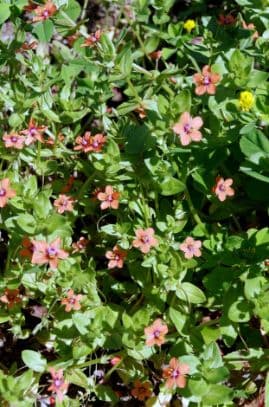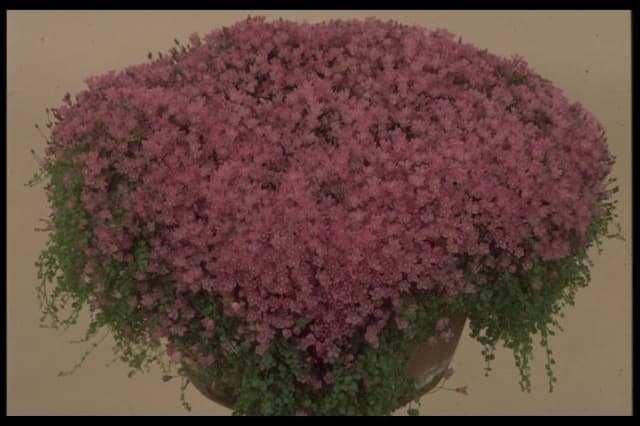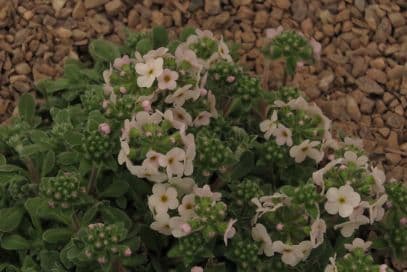Broadwell Milkmaid Primula 'Broadwell Milkmaid' (Au)

ABOUT
The Primula 'Broadwell Milkmaid' is a delightful perennial known for its attractive, delicate flowers. Its blossoms display a creamy yellow hue which presents a soft, milky appearance, resembling the attire of a traditional milkmaid. The flowers are typically characterized by a round shape with rounded petals that are elegantly arranged around a central eye. This eye often exhibits a contrasting color which adds a striking emphasis to the overall flower structure. The plant's foliage consists of a rosette of leaves that are lush and green, creating a lovely contrast with the light-colored blooms. The leaves may have a slight texture, with distinct veining and sometimes a subtle scalloped or serrated edge, enhancing the ornamental quality of the plant. Overall, the Primula 'Broadwell Milkmaid' offers a charming display with its pastel flowers and complementary greenery, making it a popular choice for gardeners seeking to add a touch of serene beauty to their outdoor spaces.
About this plant
 Names
NamesFamily
Primulaceae.
Synonyms
Broadwell Milkmaid.
Common names
Primula 'Broadwell Milkmaid'
 Toxicity
ToxicityTo humans
Primroses, including the Primula 'Broadwell Milkmaid', are generally considered safe and are not known to be toxic to humans if ingested in small quantities. However, some individuals may experience mild stomach upset or dermatitis from handling the plant, particularly if they have sensitive skin or an existing allergy.
To pets
Primroses, such as the Primula 'Broadwell Milkmaid', are typically non-toxic to pets. However, consumption of any plant material may cause gastrointestinal upset in some pets, such as vomiting or diarrhea. If a pet ingests a large amount of the plant, it is best to monitor them closely and consult a veterinarian if any concerning symptoms arise.
 Characteristics
CharacteristicsLife cycle
Perennials
Foliage type
Evergreen
Color of leaves
Green
Flower color
Yellow
Height
6 inches (15 cm)
Spread
8 inches (20 cm)
Plant type
Herb
Hardiness zones
5
Native area
Europe
Benefits
 General Benefits
General Benefits- Ornamental Appeal: Primula 'Broadwell Milkmaid' adds a delicate aesthetic to gardens with its soft yellow flowers and attractive foliage.
- Spring Bloomer: This plant typically flowers in the spring, offering early color to the garden after winter dormancy.
- Attracts Pollinators: Bees and butterflies are attracted to its blooms, aiding in pollination of the garden.
- Compact Size: Its small size makes it suitable for rock gardens, borders, or as a ground cover in small garden spaces.
- Shade Tolerant: It can thrive in partial shade, making it a versatile option for gardens with varying light conditions.
- Low Maintenance: Primula 'Broadwell Milkmaid' is generally easy to care for, requiring minimal maintenance beyond regular watering.
- Cold Hardy: As a hardy perennial, it can survive in cooler climates, returning each year with proper care.
 Medical Properties
Medical PropertiesThis plant is not used for medical purposes.
 Air-purifying Qualities
Air-purifying QualitiesThis plant is not specifically known for air purifying qualities.
 Other Uses
Other Uses- The leaves of the Primula can be used as a natural dye for fabrics, providing a range of soft yellow to green hues depending on the mordant used.
- The flowers can be crystallized and used as edible decorations for cakes and desserts, giving a touch of elegance and a mild flavor.
- Crushed Primula petals can be infused into oils or vinegars to impart a subtle floral aroma and flavor to gourmet culinary creations.
- The vibrant flowers can be used in potpourri mixes to add color and a light, pleasant scent to a room.
- Primula flowers can serve as a natural indicator of soil pH; they prefer slightly acidic to neutral soil, and can indicate soil conditions when thriving or struggling.
- These flowers can be used in crafting, such as pressing them for bookmarks or incorporating them into homemade paper for a unique texture and aesthetic.
- As a companion plant in the garden, Primula can attract beneficial insects that help in the pollination of nearby plants and vegetables.
- The petals of Primula can be used to create floral ice cubes that add a decorative touch to summertime drinks and cocktails.
- Dried Primula blooms can be incorporated into herbal sachets that when placed in drawers or closets, can impart a fresh, floral scent to linens and clothing.
- When used in a landscaping context, Primula can function as a living mulch, covering the ground and helping to retain soil moisture and suppress weeds.
Interesting Facts
 Feng Shui
Feng ShuiThe Primrose is not used in Feng Shui practice.
 Zodiac Sign Compitability
Zodiac Sign CompitabilityThe Primrose is not used in astrology practice.
 Plant Symbolism
Plant Symbolism- Youthfulness: The Primula, commonly referred to as "Primrose," often symbolizes youth and renewal due to its early spring blooming.
- Hope: Primroses are one of the first flowers to bloom in the spring, heralding the end of winter, making them a symbol of hope and new beginnings.
- Love and Affection: Giving primroses can be a way to express love and caring for someone, as they are often associated with a variety of positive emotions.
- Patience: Primroses have been known to symbolize patience due to their tendency to grow and bloom under adversity and in challenging environments.
 Water
WaterThe English Primrose should be watered thoroughly when the top inch of soil feels dry to the touch, which might be roughly once a week, although this frequency will depend on environmental conditions such as temperature and humidity. Ensure that water penetrates through the drainage holes to fully saturate the root zone. Avoid overwatering, which can lead to root rot; typically, providing about 16 ounces of water will suffice for a smaller pot. During the active growing season in spring, the plant may require more frequent watering, especially if it’s outdoor in warmer weather, while in winter, when the plant is not actively growing, it may need less.
 Light
LightThe English Primrose thrives best in partial shade, out of direct midday sun, which can be too intense and may cause the leaves to scorch. A location that receives filtered sunlight or a few hours of morning sun with afternoon shade is ideal. The delicate flowers and foliage will appreciate protection from the harsh afternoon rays, so positioning the plant under a tree canopy or next to taller plants can provide the necessary light conditions.
 Temperature
TemperatureEnglish Primroses prefer cool to moderate temperatures, ideally between 60°F and 75°F, which align with their natural growing conditions. They can tolerate a temperature range from just above freezing, around 32°F, to about 80°F, though prolonged exposure to the higher end of this range may stress the plant. It's important to avoid exposing the English Primrose to extreme temperatures, both hot and cold, to ensure healthy growth and flowering.
 Pruning
PruningPrune the English Primrose after flowering by removing spent flower stalks to encourage additional blooms and maintain the plant's appearance. Deadheading, the process of removing faded flowers, often stimulates a second flush of blossoms. Pruning can be done as needed throughout the blooming season, typically in spring and summer. The best time for more extensive pruning or cutting back the foliage if it becomes ragged is just after the plant has finished its main flowering period.
 Cleaning
CleaningAs needed
 Soil
SoilThe best soil for the Cowslip (common name for Primula 'Broadwell Milkmaid') is a well-draining, loamy mixture rich in organic matter. A pH level ranging from 6.0 to 7.5 is ideal to promote healthy growth. Adding peat, compost, or well-rotted manure can enhance the soil's fertility and structure.
 Repotting
RepottingCowslips should be repotted every one to two years to maintain healthy growth and soil fertility. It's best to repot these plants in the spring, just before the onset of their growth period.
 Humidity & Misting
Humidity & MistingCowslips prefer moderate to high humidity levels but are fairly adaptable to typical indoor humidity ranges. Maintaining a humidity level around 50% is usually sufficient for healthy growth.
 Suitable locations
Suitable locationsIndoor
Grow Cowslip in bright, indirect light with well-draining soil.
Outdoor
Plant Cowslip in partial shade, and shelter from harsh weather.
Hardiness zone
4-8 USDA
 Life cycle
Life cyclePrimula 'Broadwell Milkmaid', commonly known as Broadwell Milkmaid Primrose, starts its life as a seed that germinates in moist, well-drained soil, typically in cool to temperate climates. Once germinated, the seedling emerges and develops into a rosette of leaves, staying close to the ground. The plant enters a vegetative stage where it grows and matures, producing more leaves that form a denser rosette. Following the vegetative stage, the Broadwell Milkmaid Primrose enters the flowering stage, usually in late winter to spring, where it produces clusters of creamy-yellow flowers that attract pollinators. After pollination, the flowers develop into capsules containing small seeds, which when mature, are dispersed to begin a new cycle. During the winter or colder months, the plant may enter dormancy, conserving energy and resources until favorable growing conditions return.
 Propogation
PropogationPropogation time
Spring-Early Summer
Propogation: Primula 'Broadwell Milkmaid', commonly known as the Broadwell Milkmaid primrose, is commonly propagated through division, which is the most popular method. This technique is best performed immediately after the plant has finished flowering, which usually occurs in late spring or early summer. To propagate by division, carefully dig up the parent plant, maintaining a substantial amount of soil around the roots. Using a clean, sharp tool, such as a garden knife or spade, the clump should be separated into smaller sections, each with several leaves and a healthy root system. These divisions can then be replanted in well-draining soil, spaced approximately 6 to 12 inches (about 15 to 30 centimeters) apart, and watered thoroughly to establish them. This method stimulates fresh growth and helps maintain the vigor of the plant while also increasing the number of plants in your garden.









